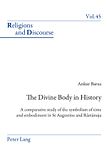Divine Body in History
Barua, Ankur:
The divine body in history : a comparative study of the symbolism of time and embodiment in St Augustine and Rāmānuja / Ankur Barua. - Oxford ; Bern ; Berlin ; Bruxelles ; Frankfurt, M. ; New York, NY ; Wien : Lang, 2009. - XIII, 235 S. - (Religions and discourse ; Vol. 45)
ISBN 978-3-03-911917-2
EUR 35,30
Beschreibung
This is a study in the field of comparative philosophy of religion. It initiates a dialogue between St Augustine and Ramanuja by focusing on two central themes - time and embodiment - that play a crucial role in their thought. The elaborations of these two themes by St Augustine and Ramanuja have continued to exert a tremendous influence on the histories of European thought and of Hindu movements centred around the notion of bhakti. The examination of the symbolism through which these thinkers articulate their understanding of time and embodiment also challenges certain stereotypes related to classical Indian thought and Latin Christendom, such as the former's lack of historical consciousness and the latter's denigration of the human body. This study shows how the 'west' and 'east' have traditionally engaged with concepts such as temporality, progress and the metaphysical status of finite and bio-physical reality. [Verlagsinformation]
Inhalt
Preface. vii
Abbreviations. xi
1. INTRODUCTION. 1
- The Symbolism of Time and Embodiment. 5
- St Augustine and Rämänuja. 11
- The Two Theologians and Their Traditions. 19
- Conclusion. 28
2. HUMAN EMBODIMENT IN A TEMPORAL WORLD. 33
- Starting the Conversation. 36
- Symbolising Embodiment, Human and Divine. 39
- Locating the 'Body'. 43
- Symbolising Human Embodiment. 47
- The Notion of 'Hierarchy' : Some Contemporary Issues. 81
- Concluding Remarks. 84
3. DIVINE EMBODIMENT IN FINITE REALITY. 87
- Symbolising Time. 87
- The 'Origins' of the Temporal World. 90
- Being and Nothingness. 94
- The Doctrine of ' Creation' : A Comparative Analysis. 97
- The Dependent World. 99
- The Immanent Ruler. 104
- The Question of 'Pantheism' : A Comparative Examination. 109
- The Intimate Presence: A Mutual Concern. 114
- The Governor of the Temporal World. 117
- The Reality of Temporal Existence: A Mutual Emphasis. 139
- The Divine Body. 141
- Concluding Remarks. 145
4. HUMAN EMBODIMENT IN THE DIVINE BODY. 147
- Of Human Bondage. 148
- The 'Ordering of Embodied Desires': A Common Theme. 153
- The'Elected'Body. 155
- The Temporal Body. 161
- The 'Openness' of the Future: A Comparative Enquiry. 165
- Entering the Divine Body. 168
- The Notion of 'Reincarnation' : Some Comparative Problems. 172
- Temporal Existence in the Divine Body. 176
- The Goodness of the Human Body. 202
- Concluding Remarks. 206
5. GENERAL CONCLUSION. 209
- Straining Towards the Divine. 209
- Labour and Contemplation. 214
- The Inclusive Body. 217
- The New World. 220
- The 'Idea of Progress': A Comparative Analysis. 227
- The Notion of 'World-Negation': Replying to Contemporary Accusations. 232
- Conclusion: Human Bodies in the Divine Body. 238
Bibliography. 241
Index. 251
Autor
Ankur Barua completed his undergraduate studies at the University of Delhi before going on to pursue a second B.A. at the University of Cambridge, where he completed his Ph.D. in the Faculty of Divinity in 2005.
Quellen: Peter Lang Verlag; Deutsche Nationalbibliothek; WorldCat; Amazon.
Ähnlich
- Harimoto: God, Reason, and Yoga
- White: The Yoga Sutra of Patanjali
- Free Will, Agency, and Selfhood in Indian Philosophy
- Moksopaya ... Teil 4
- Der Weg zur Befreiung ... Buch 4
- Jeremiah: Community and Worldview among Paraiyars of South India
- Cross: Schopenhauer's Encounter with Indian Thought
- Todd: The Ethics of Śaṅkara and Śāntideva
- Liebau: Cultural Encounters in India
- Periodization and Historiography of Indian Philosophy

